First Balkenende cabinet | |
|---|---|
Cabinet of the Netherlands | |
  The installation of the first Balkenende cabinet on 22 July 2002 | |
| Date formed | 22 July 2002 |
| Date dissolved | 27 May 2003 (Demissionary from 16 October 2002) |
| People and organisations | |
| Monarch | Queen Beatrix |
| Prime Minister | Jan Peter Balkenende |
| Deputy Prime Minister | Eduard Bomhoff (2002) Johan Remkes Roelf de Boer (2002–2003) |
| No. of ministers | 14 |
| Ministers removed | 3 |
| Total no. of members | 14 |
| Member party | Christian Democratic Appeal (CDA) Pim Fortuyn List (LPF) People's Party for Freedom and Democracy (VVD) |
| Status in legislature | Right-wing Majority government |
| History | |
| Election | 2002 election |
| Outgoing election | 2003 election |
| Legislature terms | 2002–2003 |
| Incoming formation | 2002 formation |
| Outgoing formation | 2003 formation |
| Predecessor | Second Kok cabinet |
| Successor | Second Balkenende cabinet |
| Part of the Politics series |
![Azure, billetty Or a lion with a coronet Or armed and langued Gules holding in his dexter paw a sword Argent hilted Or and in the sinister paw seven arrows Argent pointed and bound together Or. [The seven arrows stand for the seven provinces of the Union of Utrecht.] The shield is crowned with the (Dutch) royal crown and supported by two lions Or armed and langued gules. They stand on a scroll Azure with the text (Or) "Je Maintiendrai" (French for "I will maintain".)](http://upload.wikimedia.org/wikipedia/commons/thumb/8/8f/State_coat_of_arms_of_the_Netherlands.svg/150px-State_coat_of_arms_of_the_Netherlands.svg.png) |
|---|
|
|
The first Balkenende cabinet was the executive branch of the Netherlands government from 22 July 2002 until 27 May 2003. The cabinet was formed by the Christian-democratic Christian Democratic Appeal (CDA), the nationalistic Pim Fortuyn List (LPF) and the conservative-liberal People's Party for Freedom and Democracy (VVD) after the election of 2002. The cabinet was a right-wing coalition and had a substantial majority in the House of Representatives with Christian Democratic Leader Jan Peter Balkenende serving as Prime Minister. Prominent economist Eduard Bomhoff served as Deputy Prime Minister and Minister of Health, Welfare and Sport, while prominent Liberal politician Johan Remkes served as Deputy Prime Minister and Minister of the Interior and Kingdom Relations.
The cabinet served during the early unstable 2000s. Domestically, it had to deal with the fallout of the assassination of Pim Fortuyn, and internationally, with the start of the war on terror. The cabinet suffered several major internal conflicts including multiple cabinet resignations. The internal conflicts between the cabinet members of the Pim Fortuyn List led to the fall of the cabinet just 87 days into its term on 16 October 2002 and it continued in a demissionary capacity until it was replaced following the election of 2003.[1]